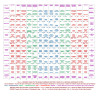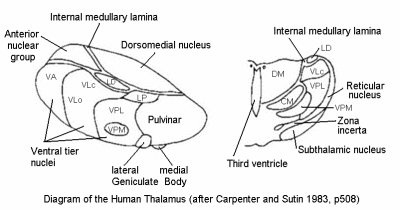Announcing the introduction of the first Periodic Table for the Human Forebrain; which enjoys similar advantages to the dramatic influence that the Periodic Table of the Elements has enjoyed with respect to Chemistry and Physics. This respective neural counterpart imparts a crucial sense of systematic order and purpose to the fragmented state of affairs currently prevailing within the neurosciences.
The cerebral cortex represents the most logical initiation point for such an innovation, celebrated as the crowning culmination of human forebrain evolution. This radical expansion of the neocortex is observed to occur in a discrete pattern suggestively termed cortical growth rings. The general pattern of neural evolution specifies that older structures are periodically modified to create newer functional areas, with the precursor circuitry also preserved, all persisting side by side. The stepwise repetition of these processes over the course of mammalian evolution ultimately accounts for the six sequential age levels of cortical evolution, schematically depicted. The diagram shown to the left depicts the entire surface of the cortex folded flat so that the medial and sub-temporal surfaces are fully exposed.
The two fundamental variables defining forebrain evolution are the parameters of phylogenetic age and input specificity. Sanides (1972) proposed that the human cortex evolved as a sequence of five concentric growth rings comprising a medio-lateral hemisphere gradient. Furthermore, the interoceptive, exteroceptive and proprioceptive input categories each project to their own four-part complex of cortical bands that (when taken collectively) define an antero-posterior hemisphere gradient. The para-coronal variable of phylogenetic age is plotted as the ordinate and the para-sagittal parameter of input specificity charted as the abscissa in a Cartesian coordinate system. Each cortical area described by Broadman and von Economo corresponds to schematically unique age/input parameter coordinates. Furthermore, each affiliated thalamic nucleus of specific age and input coordinates projects principally to that cortical area comprising identical pair-coordinate values, implying that the evolution of both the dorsal thalamus and the cortex are similarly defined in terms of the specifics for the dual parameter grid. Please use the full-screen option to access the most detailed view of the diagrams... A more detailed text narrative comprising more than 30,000 words may be accessed by clicking on the links below including the Mission Statement and The Evolution of the Cortex/Thalamus Sections.
The two fundamental variables defining forebrain evolution are the parameters of phylogenetic age and input specificity. Sanides (1972) proposed that the human cortex evolved as a sequence of five concentric growth rings comprising a medio-lateral hemisphere gradient. Furthermore, the interoceptive, exteroceptive and proprioceptive input categories each project to their own four-part complex of cortical bands that (when taken collectively) define an antero-posterior hemisphere gradient. The para-coronal variable of phylogenetic age is plotted as the ordinate and the para-sagittal parameter of input specificity charted as the abscissa in a Cartesian coordinate system. Each cortical area described by Broadman and von Economo corresponds to schematically unique age/input parameter coordinates. Furthermore, each affiliated thalamic nucleus of specific age and input coordinates projects principally to that cortical area comprising identical pair-coordinate values, implying that the evolution of both the dorsal thalamus and the cortex are similarly defined in terms of the specifics for the dual parameter grid. Please use the full-screen option to access the most detailed view of the diagrams... A more detailed text narrative comprising more than 30,000 words may be accessed by clicking on the links below including the Mission Statement and The Evolution of the Cortex/Thalamus Sections.
Major Nuclei of the Thalamus
Depicting the Major Lateral, Dorso-Medial and Pulvinar/Geniculate Subdivisions
Descriptive Web-Links
Click Here for a More Detailed Description of the Cortical Growth Rings
Mission Statement
Overview of Behaviorism and the Human Forebrain
Contact John LaMuth
Contact Information
The Evolution of the Thalamus
The Evolution of the Thalamus
The Evolution of the Cortex
The Evolution of the Cortex
Input Specificity
Input Specificity in the Forebrain
Forebrain in Relation to the Brainstem
Forebrain vs. Brainstem
Accessory Links
Additional Links from John LaMuth
Philosophical Correlates
Hemisphere Asymmetry and Philosophical Reflection
Behavioral Applications
Behavioral Applications
World-peace
Inroads towards World-Peace
Click Here for a More Detailed Description of the Cortical Growth Rings
Mission Statement
Overview of Behaviorism and the Human Forebrain
Contact John LaMuth
Contact Information
The Evolution of the Thalamus
The Evolution of the Thalamus
The Evolution of the Cortex
The Evolution of the Cortex
Input Specificity
Input Specificity in the Forebrain
Forebrain in Relation to the Brainstem
Forebrain vs. Brainstem
Accessory Links
Additional Links from John LaMuth
Philosophical Correlates
Hemisphere Asymmetry and Philosophical Reflection
Behavioral Applications
Behavioral Applications
World-peace
Inroads towards World-Peace
Comments (0) | Add a Comment





